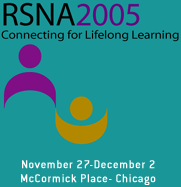
Abstract Archives of the RSNA, 2005
Vijaykalyan Yeluri MS, Presenter: Nothing to Disclose
Robert John Herfkens MD, Abstract Co-Author: Nothing to Disclose
Denny Lau MS, Abstract Co-Author: Nothing to Disclose
Graham Sommer MD, Abstract Co-Author: Nothing to Disclose
The advent of new scanner technologies allows the modalities to scan faster with thinner slices resulting in studies with more images. A radiologist can view acquired images on a PACS workstation but needs to use either a stand-alone 3D workstation or request a dedicated 3D lab to generate multiplanar reformatted views and volume rendered images. Integration of 3D post processing tools with a PACS diagnostic reading workstation enables a radiologist to generate reformats/volume renderings quickly and efficiently. The purpose of this study was to compare changes in workflow and impact on productivity between using a conventional PACS workstation versus an integrated 3D-PACS workstation for image interpretation.
A conventional two monitor GE PACS Centricity RA1000 diagnostic workstation was used as a baseline comparison with a new three monitor Centricity RA 1000 workstation that integrates Advantage Windows’ 3D image processing and viewing capabilities allowing a radiologist to create reformatted and volume rendered images in the context of PACS.
Radiologists use the AWSuite software in a clinical environment to interpret large CT and MR data sets. The software is also used for multi-modality exams such as PET-CT. Ongoing studies are being conducted to capture impact to radiologists from availability of features such as generating and saving fused PET-CT images, orthogonal planar reformats and volume renderings on PACS. The impact to workflow and productivity will be characterized by referring physician satisfaction, radiologists’ confidence in diagnosis, impact to radiologists’ productivity with automatic image organization through hanging protocols, and time spent interpreting images per exam.
The comparative advantages and disadvantages of different workflows to generate reformations will also be reviewed.
The use of 3D post processed images in the context of 2D acquisition images significantly impacts the way radiologists interpret exams. Future improvements to the integration of 3D image processing and viewing capabilities to PACS workstations should lead to wider adoption and acceptance of using post processed images for interpretation.
V.Y.,D.L.: work for GE Healthcare
Yeluri, V,
Herfkens, R,
Lau, D,
Sommer, G,
Interpreting Large Volumetric and Multimodality Data Sets in an Integrated 3D-PACS Environment. Radiological Society of North America 2005 Scientific Assembly and Annual Meeting, November 27 - December 2, 2005 ,Chicago IL.
http://archive.rsna.org/2005/4414953.html

